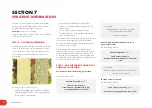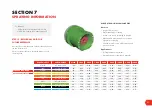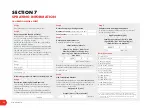
HT-OMSMART-A
76
Every 250 hours or Every Season
- Whichever Comes Sooner
1. Change oil and refill with 20W/30 oil. Attention
should be made to remove trapped air behind the
diaphragms by rocking from side to side as instructed.
It is also good practise run the pump for 10 minutes
without pressure, and then, top up with oil before
working the pump.
2. When changing the pump oil, check diaphragms and
replace them if they are showing signs of wear.
Diaphragm valves should be replaced every 400
hours regardless of wear.
This is normally a pre-season maintenance procedure
which can be done easily as no special tools are
required.
You can avoid unnecessary down time in spraying
seasons by carrying out preventative maintenance.
3. Also check inlet and outlet valves and replace if worn.
Worn valves not only reduce the output of the pump,
but may reduce the life of the diaphragms.
Excessive Diaphragm Failure
If you have excessive diaphragm failure check the
following points. These will cause failure of diaphragms
due to added stress or chemical attack.
1. Most Important - Pump not being flushed out daily with
clean water after use.
2. Oil level too low allowing air between piston and
diaphragm.
3. Air leaks in suction line.
4. Restricted suction line.
5. Restriction through suction filter.
6. Not cleaning suction filter regularly.
7. Worn suction and discharge valves.
8. Bypass line too small to carry full capacity of pump.
9. In cold climates - frozen suction/discharge lines or
water remaining in the pump after flushing.
10. Incorrect air setting or no air in air chamber.
11. Agitator excessively restricting bypass from pump.
12. Diaphragm material construction incorrect for
chemical or solution being pumped.
13. Chemicals containing toluene or other aggressive
solvents may require viton diaphragms - particularly
if the pump is not properly flushed after use.
Pre-Season Servicing
For thorough pre-season servicing - check all aspects
of the Quantum Mist and its operating components as
outlined in the pre-delivery check list.
Pump Storage and Corrosion Protection
1. Warm Climates
If you operate in a warm climate with no chance of
frost in the winter, you will not have any problems with
frost damage.
If you are storing your sprayer between seasons, ensure
your pump has been thoroughly flushed with clean
water. A good idea is to run a mixture of 1% solution
of summer mineral spraying oil through the pump and
plumbing system. Summer spraying oil is water-soluble
oil such as DC-Tron. This will coat and protect all
internal pump parts. Ensure this mixture is flushed out
before spraying commences in the new season.
2. Cold Climates
For prolonged storage, an anti-freeze mixture can be
flushed through the pump. Ensure this is thoroughly flushed
out prior to the commencement of spraying again.
If the pump is being stored overnight and a risk of
freezing is imminent, drain all liquid from the pump
and lines, including boom lines.
FILTERS
Filter Maintenance
Clean filters ensure that no solids enter the spraying system
to block or damage pump or nozzles.
All filters should be cleaned regularly or after each
spraying period.
Suction Filter
The suction filter should be cleaned regularly, or after each
spray tank has been emptied.
SECTION 9
LUBRICATION & MAINTENANCE
The pump suction valve CLOSED to the main tank






























